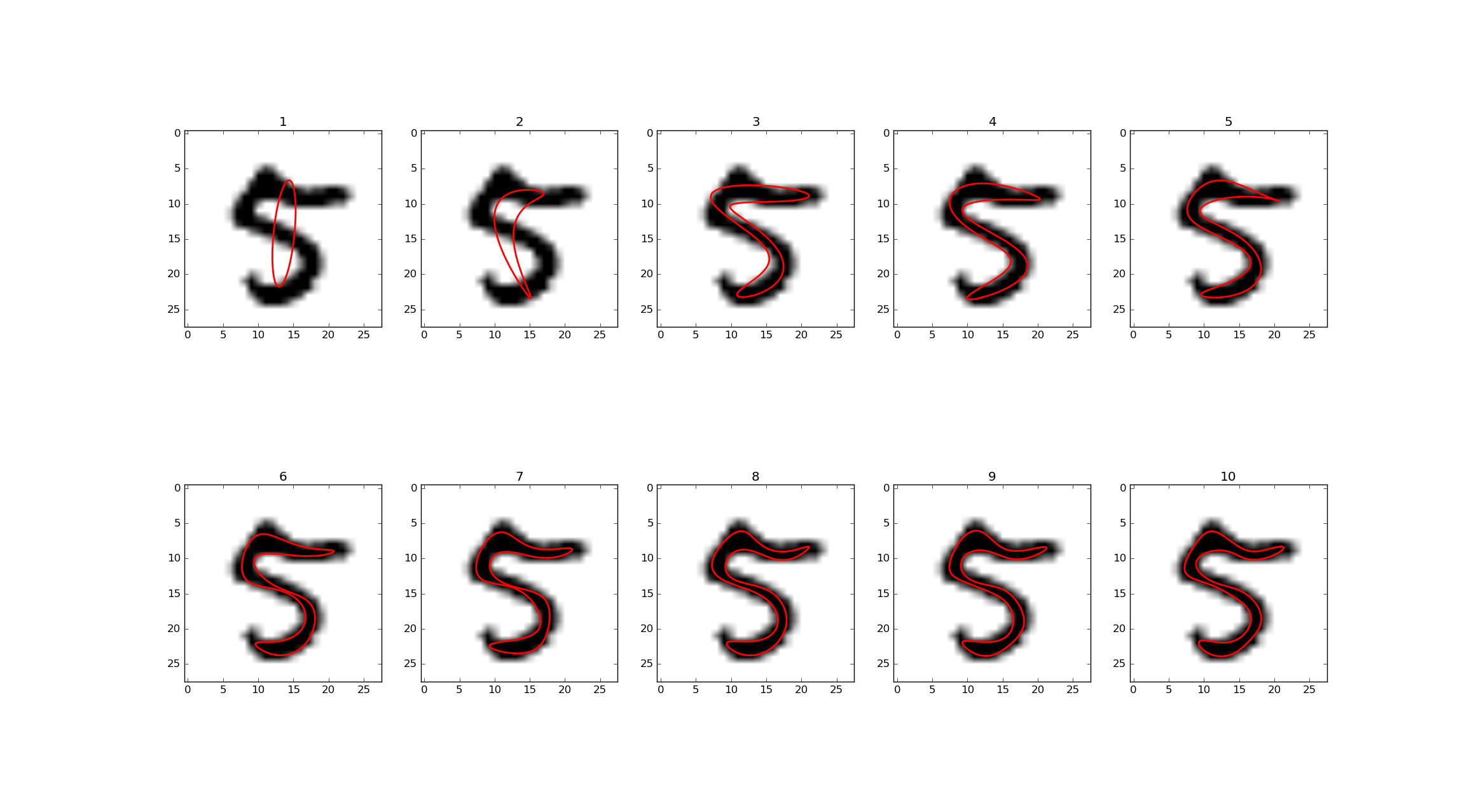PyEFD¶



An Python/NumPy implementation of a method for approximating a contour with a Fourier series, as described in [1].

EFD representations of an MNIST [2] digit. Shows progressive improvement of approximation by order of Fourier series.
Installation¶
$ pip install pyefd
Usage¶
Given a closed contour of a shape, generated by e.g. scikit-image or OpenCV, this package can fit a Fourier series approximating the shape of the contour:
from pyefd import elliptic_fourier_descriptors
coeffs = elliptic_fourier_descriptors(contour, order=10)
The coefficients returned are the \(a_n\), \(b_n\), \(c_n\) and \(d_n\) of the following Fourier series representation of the shape.
The coefficients returned are by default normalized so that they are rotation and size-invariant. This can be overridden by calling:
from pyefd import elliptic_fourier_descriptors
coeffs = elliptic_fourier_descriptors(contour, order=10, normalize=False)
Normalization can also be done afterwards:
from pyefd import normalize_efd
coeffs = normalize_efd(coeffs)
To use these as features, one can write a small wrapper function:
def efd_feature(contour):
coeffs = elliptic_fourier_descriptors(contour, order=10, normalize=True)
return coeffs.flatten()[3:]
If the coefficients are normalized, then coeffs[0, 0] = 1.0,
coeffs[0, 1] = 0.0 and coeffs[0, 2] = 0.0, so they can be disregarded when using
the elliptic Fourier descriptors as features.
See [1] for more technical details.
Testing¶
Run tests with:
$ python setup.py test
or with Pytest:
$ py.test tests.py
The tests includes a single image from the MNIST dataset of handwritten digits ([2]) as a contour to use for testing.
References¶
| [2] | (1, 2) LeCun et al. (1999): The MNIST Dataset Of Handwritten Digits |
API¶
A Python implementation of the method described in [3] and [4] for calculating Fourier coefficients for characterizing closed contours.
References¶
| [3] | (1, 2, 3) F. P. Kuhl and C. R. Giardina, “Elliptic Fourier Features of a Closed Contour,” Computer Vision, Graphics and Image Processing, Vol. 18, pp. 236-258, 1982. |
| [4] | (1, 2, 3) Oivind Due Trier, Anil K. Jain and Torfinn Taxt, “Feature Extraction Methods for Character Recognition - A Survey”, Pattern Recognition Vol. 29, No.4, pp. 641-662, 1996 |
Created by hbldh <henrik.blidh@nedomkull.com> on 2016-01-30.
-
pyefd.calculate_dc_coefficients(contour)[source]¶ Calculate the \(A_0\) and \(C_0\) coefficients of the elliptic Fourier series.
Parameters: contour (numpy.ndarray) – A contour array of size [M x 2].Returns: The \(A_0\) and \(C_0\) coefficients. Return type: tuple
-
pyefd.elliptic_fourier_descriptors(contour, order=10, normalize=False)[source]¶ Calculate elliptical Fourier descriptors for a contour.
Parameters: - contour (numpy.ndarray) – A contour array of size
[M x 2]. - order (int) – The order of Fourier coefficients to calculate.
- normalize (bool) – If the coefficients should be normalized; see references for details.
Returns: A
[order x 4]array of Fourier coefficients.Return type: numpy.ndarray- contour (numpy.ndarray) – A contour array of size
-
pyefd.normalize_efd(coeffs, size_invariant=True)[source]¶ Normalizes an array of Fourier coefficients.
Parameters: - coeffs (numpy.ndarray) – A
[n x 4]Fourier coefficient array. - size_invariant (bool) – If size invariance normalizing should be done as well.
Default is
True.
Returns: The normalized
[n x 4]Fourier coefficient array.Return type: numpy.ndarray- coeffs (numpy.ndarray) – A
-
pyefd.plot_efd(coeffs, locus=(0.0, 0.0), image=None, contour=None, n=300)[source]¶ Plot a
[2 x (N / 2)]grid of successive truncations of the series.Note
Requires matplotlib!
Parameters: